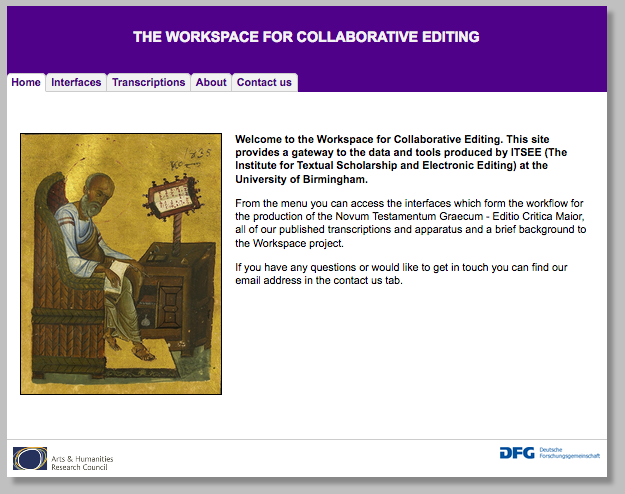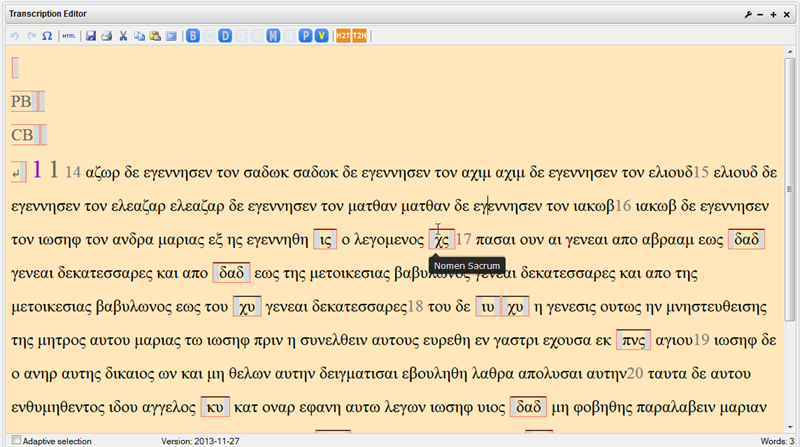The Workspace for Collaborative Editing was a collaborative Anglo-German project funded by the UK Arts and Humanities Research Council (AHRC) and the Deutsche Forschungsgemeinschaft (DFG) between 2010 and 2013.
The goal was to create an online workspace to support the creation of a new edition of the Greek New Testament, the Novum Testamentum Graecum: Editio Critica Maior, undertaken by the Institut für Neutestamentliche Textforschung in Münster (INTF) and the International Greek New Testament Project (IGNTP). The platform was conceived as a replacement to the Collate software created by Peter Robinson, used since 1995 by both projects but now obsolete. The specifications included the creation of a user-friendly online interface to create XML transcriptions of New Testament manuscripts and a collation tool using the CollateX algorithm developed by the INTEREDITION consortium, with the integration of tools for analysis of the manuscript tradition (the Münster Coherence-Based Genealogical Method) and addition of patristic and versional material to the apparatus. The project received funding of £217,239 from the AHRC and £228,698 from the DFG, making a total budget of £445,937.
 The original application for funding the Workspace for Collaborative Editing was made by Peter Robinson (Birmingham) and Claudine Moulin (Trier). The project was delivered by three partners:
The original application for funding the Workspace for Collaborative Editing was made by Peter Robinson (Birmingham) and Claudine Moulin (Trier). The project was delivered by three partners:
- The Institute for Textual Scholarship and Electronic Editing, University of Birmingham, UK (ITSEE)
Hugh Houghton (Principal Investigator), David Parker (Co-principal Investigator), Zeth Green, Catherine Smith
- Kompetenzzentrum für elektronische Erschließungs- und Publikationsverfahren in den Geisteswissenschaften, Universität Trier, DE (Trier Center for Digital Humanities, TCDH)
Thomas Burch, Martin Sievers, Gan Yu
- Institut für Neutestamentliche Textforschung, WWU Münster, DE (INTF)
Klaus Wachtel, Marie Luise Lakmann, Ulrich Schmid, Troy Griffitts, Matthias Piontek
A demonstration of the Workspace was presented at the DH2014 congress in Lausanne, Switzerland. Presentations have also been given at a number of other scholarly gatherings, including the Annual Meeting of the Society of Biblical Literature (San Francisco 2011; Chicago 2012; Baltimore 2013) and conferences organised by the DIXIT consortium.
The software created by the project has been released under Creative Commons licensing:
The interface for the tools hosted by Birmingham is itsee-wce.birmingham.ac.uk. Many of the tools have also been incorporated into the New Testament Virtual Manuscript Room (NT.VMR, University of Münster) and are available for download as part of the VMR-CRE package developed by Troy Griffitts. In addition to their adoption by a variety of projects working on the New Testament and Coptic Bible, the software will also be incorporated into the ERC-funded Multimedia Yasna project led by Prof. Almut Hintze at SOAS, University of London.
Publications associated with the Workspace for Collaborative Editing project include:
- D.C. Parker, Textual Scholarship and the Making of the New Testament, Oxford: OUP, 2012.
- H.A.G. Houghton, "The Electronic Scriptorium: Markup for New Testament Manuscripts", in Claire Clivaz, Andrew Gregory and David Hamidović (edd.), Digital Humanities in Biblical, Early Jewish and Early Christian Studies. (Scholarly Communication 2). Leiden: Brill, 2014. (pp. 31-60), available here.
- H.A.G. Houghton and C.J. Smith, "Digital Editing and the Greek New Testament" in Claire Clivaz, Paul Dilley and David Hamidović (edd.), The Ancient World in Digital Culture. Digital Biblical Studies 1. Leiden: Brill, 2016, available in Open Access.
Two guides are hosted in the University of Birmingham's Institutional Research Archive:
The project homepage is found on the TCDH website. A limited selection of information about the project can also be found on the Research Councils UK Gateway to Research.
